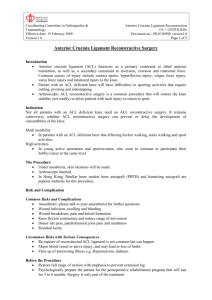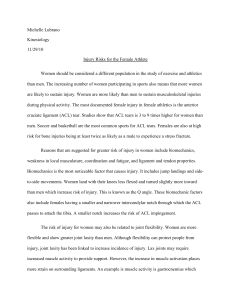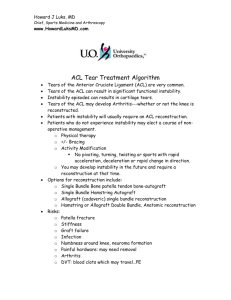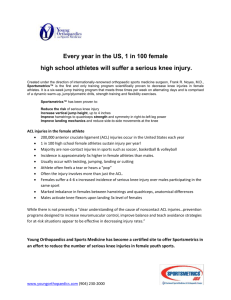Knee Pain and Injuries
advertisement
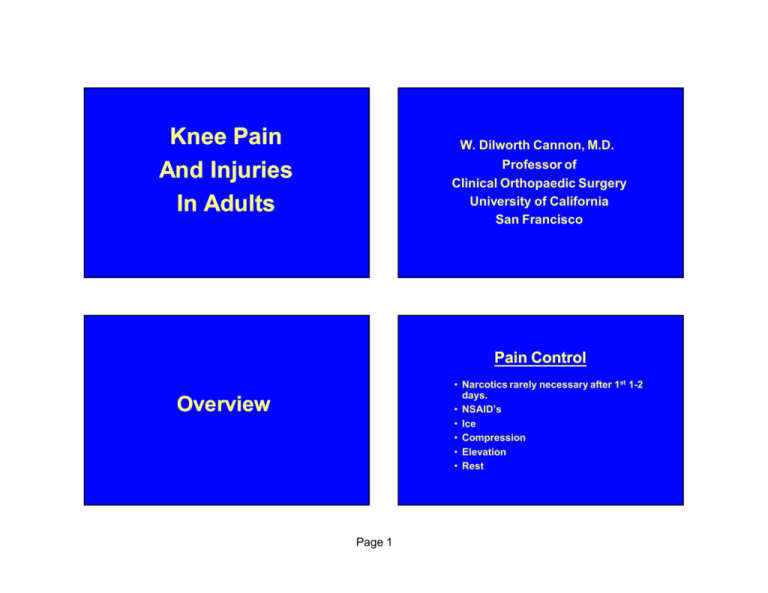
Knee Pain And Injuries In Adults W. Dilworth Cannon, M.D. Professor of Clinical Orthopaedic Surgery University of California San Francisco Pain Control • Narcotics rarely necessary after 1st 1-2 days. • NSAID’s • Ice • Compression • Elevation • Rest Overview Page 1 Football Injury Football Injury Ligament Sprains Grade I Grade II Grade III Page 2 Grades of Laxity Primary Care Physicians: 1+ = 3-5 mm 2+ = 5-10 mm 3+ = >10 mm “A-P and lateral of knee” (occasionally “Sunrise view”) My Routine X-rays Include: 1. P-A bent knee standing film both knees (Knees bent 30-45 deg, aim beam 10 deg caudad) 2. Lateral (supine) 3. 30°patello-femoral axial view Page 3 Patello-Femoral View: • Don’t omit ordering this view • Don’t order “Sunrise View” • Order Merchant’s View (45 deg view), or 30 deg view. Page 4 When should you order an MRI? Locking Causes of Locking: • Displaced meniscus tear • Loose body • Swollen knee • Fragment of torn ACL A block to full extension. Can flex Page 5 Management of the ACL Deficient Knee Epidemiology: Natural History of ACL Tear: • Approx. 125,000 ACL tears and • Twisting injury and pop • Immediate swelling • Repeated giving way and effusions 40,000-60,000 MCL tears per year. • Female:male gymnasts/basketball players: – 3-4 times higher incidence in females. Page 6 “Office Sprain” “Telephone” Diagnosis • 72% are ACL tears • Exam substantiates Dx • No longer immobilize and “pray” Fluid in Joint: •Immediate = blood •After 24 hours = effusion Page 7 Knee Model mpg2 Knee Model mpg 1 Acute ACL Tear: • Lachman test • Pivot shift or Losee test • Arthrometer measurements • MRI for assessment of menisci Page 8 Joint Immobilization: • Muscle atrophy • Adhesions and joint stiffness • Decreased ROM • Cartilage degeneration • Ligament strength deterioration Eriksson: Early Motion (mpg 1) Eriksson: Early Motion (mpg2) Page 9 Losee, Lachman, Pivot Shift Tests Losee Test • A “gentle” test compared to pivot shift. • Most useful if MCL and ACL torn. Non--operative treatment Non Anterior Drawer: of the May miss up to 50% of ACL deficient knee acute ACL tears Page 10 Aggressive rehabilitation: Don’t do this! • Early return of motion • Hamstring strengthening • Closed kinetic chain quads Rule of Thirds: • 1/3 can play recreational sports • 1/3 cannot play recreational sports • 1/3 have symptoms with ADL Page 11 Sequelae of ACL Tear: • Meniscal tears in 30-95% • Late arthritis Page 12 If a patient wants to have the best Braces decrease, but do not chance of having a more normal eliminate anterior subluxation (stable) knee, then ACL reconstruction is the best choice. ACL Reconstruction: Rx of MCL Tears: Delay surgery approx. 6-8 wks until close to FROM obtained, swelling Non-operative down, and strength returned. Success rate: 90-95% Page 13 Medial Collateral Ligament Injuries: • Tenderness and swelling over medial aspect of knee. • Medial opening with valgus stress at 30 degrees flexion: Grade 0-3 +. • Beware of ACL injuries in grade 3 lesion. Rehabilitation of MCL Injury: • FROM in hinged brace (wear it 24/7). • Wt bearing as tolerated. • Progressive strengthening and agility program. • Return to sports at 5-9 weeks. Page 14 Torn Meniscus Partial meniscectomy versus Meniscal repair • Typically twisting or hyperflexion injury – With or without a pop • Joint line pain and tenderness • Swelling • Clicking or catching • Locking or giving way Post--meniscectomy Patient: Post • Should not jog or run • Try speed walking • Encourage bicycling • Working out is okay Page 15 PCL Posterior Cruciate Ligament • 3% - 20% of all knee ligament injuries. (PCL) • Associated injuries common. Quad Active Test Mechanism of Injury: • Posterior force to anterior tibia (dashboard). • Hyperflexion, hyperextension, twist. Page 16 Natural Hx & Rx Controversial: Lateral Collateral Ligament Surgery for some combined injuries, (LCL) rarely for isolated PCL tears. Lateral Collateral Ligament • Increased varus laxity at 30 degrees flexion. Cysts About the Knee • Non-operative Rx common. • Surgical exploration and primary repair for combined injuries. Page 17 Popliteal Cysts Secondary to intra-articular pathology Page 18 Patellar Tendinitis (“Jumper’s Knee”) Patellar tendinitis • • • • • • • Page 19 Rest Ice NSAID’s No OKC quadriceps exercises Quadriceps stretching No steroid injections Surgery only if non-op Rx fails Knee Pain And Injuries In Adults W. Dilworth Cannon, M.D. Professor of Clinical Orthopaedic Surgery University of California San Francisco Pain Control • Narcotics rarely necessary after 1st 1-2 days. • NSAID’s • Ice • Compression • Elevation • Rest Overview Page 1 Football Injury Football Injury Ligament Sprains Grade I Grade II Grade III Page 2 Grades of Laxity Primary Care Physicians: 1+ = 3-5 mm 2+ = 5-10 mm 3+ = >10 mm “A-P and lateral of knee” (occasionally “Sunrise view”) My Routine X-rays Include: 1. P-A bent knee standing film both knees (Knees bent 30-45 deg, aim beam 10 deg caudad) 2. Lateral (supine) 3. 30°patello-femoral axial view Page 3 Patello-Femoral View: • Don’t omit ordering this view • Don’t order “Sunrise View” • Order Merchant’s View (45 deg view), or 30 deg view. Page 4 When should you order an MRI? Locking Causes of Locking: • Displaced meniscus tear • Loose body • Swollen knee • Fragment of torn ACL A block to full extension. Can flex Page 5 Management of the ACL Deficient Knee Epidemiology: Natural History of ACL Tear: • Approx. 125,000 ACL tears and • Twisting injury and pop • Immediate swelling • Repeated giving way and effusions 40,000-60,000 MCL tears per year. • Female:male gymnasts/basketball players: – 3-4 times higher incidence in females. Page 6 “Office Sprain” “Telephone” Diagnosis • 72% are ACL tears • Exam substantiates Dx • No longer immobilize and “pray” Fluid in Joint: •Immediate = blood •After 24 hours = effusion Page 7 Knee Model mpg2 Knee Model mpg 1 Acute ACL Tear: • Lachman test • Pivot shift or Losee test • Arthrometer measurements • MRI for assessment of menisci Page 8 Joint Immobilization: • Muscle atrophy • Adhesions and joint stiffness • Decreased ROM • Cartilage degeneration • Ligament strength deterioration Eriksson: Early Motion (mpg 1) Eriksson: Early Motion (mpg2) Page 9 Losee, Lachman, Pivot Shift Tests Losee Test • A “gentle” test compared to pivot shift. • Most useful if MCL and ACL torn. Non--operative treatment Non Anterior Drawer: of the May miss up to 50% of ACL deficient knee acute ACL tears Page 10 Aggressive rehabilitation: Don’t do this! • Early return of motion • Hamstring strengthening • Closed kinetic chain quads Rule of Thirds: • 1/3 can play recreational sports • 1/3 cannot play recreational sports • 1/3 have symptoms with ADL Page 11 Sequelae of ACL Tear: • Meniscal tears in 30-95% • Late arthritis Page 12 If a patient wants to have the best Braces decrease, but do not chance of having a more normal eliminate anterior subluxation (stable) knee, then ACL reconstruction is the best choice. ACL Reconstruction: Rx of MCL Tears: Delay surgery approx. 6-8 wks until close to FROM obtained, swelling Non-operative down, and strength returned. Success rate: 90-95% Page 13 Medial Collateral Ligament Injuries: • Tenderness and swelling over medial aspect of knee. • Medial opening with valgus stress at 30 degrees flexion: Grade 0-3 +. • Beware of ACL injuries in grade 3 lesion. Rehabilitation of MCL Injury: • FROM in hinged brace (wear it 24/7). • Wt bearing as tolerated. • Progressive strengthening and agility program. • Return to sports at 5-9 weeks. Page 14 Torn Meniscus Partial meniscectomy versus Meniscal repair • Typically twisting or hyperflexion injury – With or without a pop • Joint line pain and tenderness • Swelling • Clicking or catching • Locking or giving way Post--meniscectomy Patient: Post • Should not jog or run • Try speed walking • Encourage bicycling • Working out is okay Page 15 PCL Posterior Cruciate Ligament • 3% - 20% of all knee ligament injuries. (PCL) • Associated injuries common. Quad Active Test Mechanism of Injury: • Posterior force to anterior tibia (dashboard). • Hyperflexion, hyperextension, twist. Page 16 Natural Hx & Rx Controversial: Lateral Collateral Ligament Surgery for some combined injuries, (LCL) rarely for isolated PCL tears. Lateral Collateral Ligament • Increased varus laxity at 30 degrees flexion. Cysts About the Knee • Non-operative Rx common. • Surgical exploration and primary repair for combined injuries. Page 17 Popliteal Cysts Secondary to intra-articular pathology Page 18 Patellar Tendinitis (“Jumper’s Knee”) Patellar tendinitis • • • • • • • Page 19 Rest Ice NSAID’s No OKC quadriceps exercises Quadriceps stretching No steroid injections Surgery only if non-op Rx fails Chondromalacia Patella Patello-Femoral Joint (“Runner’s Knee”) Page 20 Lateral Patellar Facet Compression Syndrome • Tight lateral retinaculum. • Patellar tilt without subluxation on 30 or 45 deg. views. • Consider lateral retinacular release for patients failing nonoperative treatment. Page 21 Exercise within one’s envelope of Physical therapy may help. tolerance Patellar Dislocation Page 22 Surgical Options Lat. retinacular release combined with: – Medial reefing, or – Distal tibial tubercle transfer surgery • Ice (rarely heat). Steroid Injections • NSAID’s. • Rest or reduction of the aggravating activity. Pros and cons (No more than 3/yr) • Strengthening program begun when the pain has subsided. • Slow resumption of activities and sports. Page 23 Rehearsal: 23 min + 6’40” videos = 30 min. Time allotted: 30 min. Videos McCallum 13” Knee model 29” Losee-Lachman 1’20” Eriksson interview Quad active test 4’28” 18” Patellofemoral crepitation Total: 56” 7’44” (=6’39”) Page 24 Salves, Tiger Baum: Not proven effective Page 25 Overview • ACL • MCL • PCL • LCL • Meniscus • Patello-Femoral Page 26 Arthrometer Measurements: • Difference of 3 mm or more on manual maximum or 40 lb testing is associated with a torn ACL in >90% of cases. • In my hands, more accurate than MRI. Cutting (lateral movement) may still be a problem Page 27 It’s an outpatient Non-operative treatment frequently fails to produce successful outcomes. procedure Graft Choice • Hamstrings (Semitendinosis, Gracilis) • Bone-patellar tendon-bone autograft • Central quadriceps tendon • Allografts Page 28 PCL Mechanism of Injury: • 3% - 20% of all knee ligament injuries. • Posterior force to the anterior tibia. • Associated injuries: • Hyperflexion. – ACL 75% • Hyperextension (combined with ACL injury). – MCL 50-80% • Varus or valgus rotation (combined with – Menisci 30-75% collateral ligament and ACL injury). – LCL 10% Page 29

